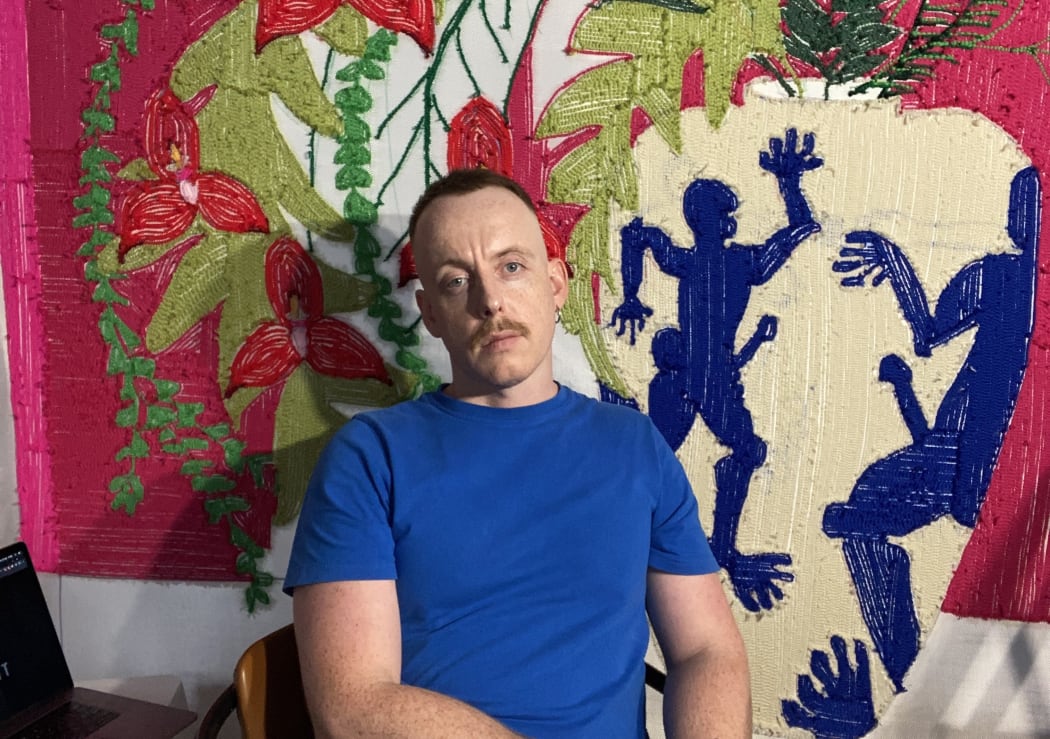
Introducing South African multidisciplinary artist Pierre le Riche, whose recent body of textile art goes on show at our Berlin gallery on February 15, 2024.
Much of le Riche’s work has been aimed at confronting themes of colonialism, race, and privilege, as well as challenging norms and associations around gender and sexuality. We chat with the artist about these themes and his process and materials in creating the vivid wall tapestries presented in the exhibition In Four Places at Once.
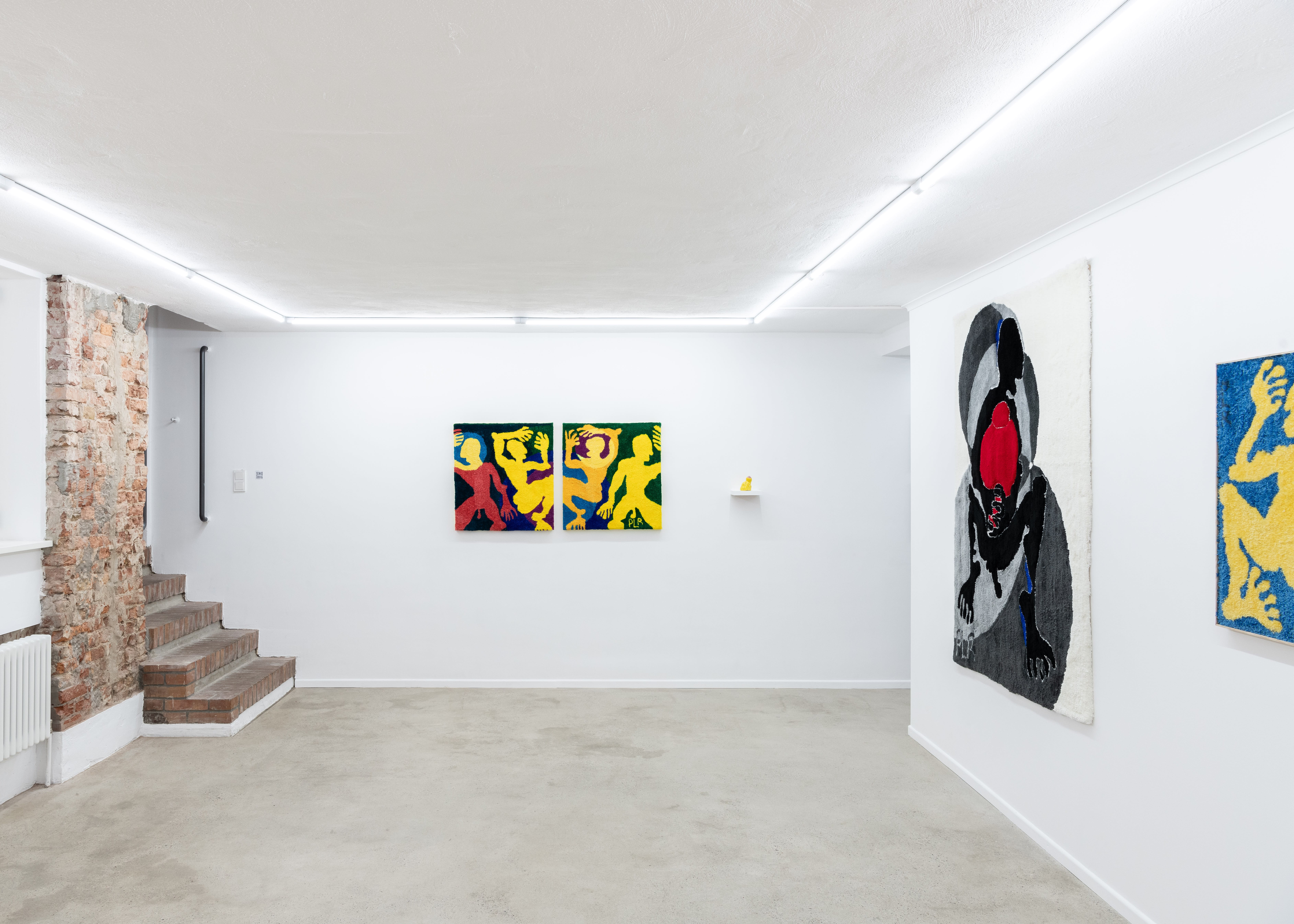
In Four Places at Once, exhibition view, 2024, Ronewa Art Projects, Berlin, Germany. Photography by Jeremy Knowles.
April Dell: Your upcoming exhibition at Ronewa Art Projects takes its title from a work of the same name, where a figure is spliced into a composition of four segments. What are the “places” this work refers to? How does your sense of place and belonging influence your practice?
Pierre le Riche: The short answer to this question is that the work stems from my state of mind since emigrating from Cape Town, South Africa to Aachen, Germany in 2022. My skin craved the African sun, the stimulation of the inner-city chaos, the natural beauty of Cape Town, and the Atlantic Ocean. Here in Aachen, I am confronted with a new language, a suburban landscape, and a new, orderly German way of life. I felt like an alien and longed to be with my family in Cape Town. So, mentally and physically, I am in two places — and two times two makes four, right?
The longer answer to this question involves me delving deeper into my Afrikaner heritage. My family, the le Riche’s, are descendants of French Huguenots — Protestants who sought refuge in South Africa when they were persecuted in France for their religious beliefs. They landed in Cape Town in the 1700s, where they integrated with other people of European descent to form the Afrikaner race. The Afrikaners are infamous for orchestrating mass segregation, or Apartheid in South Africa.
This heritage became an integral part of my current artistic practice. During my undergraduate studies, I was very distracted by my interest in gender and sexuality in the conservative Calvinist Afrikaner culture (since I am gay). My focus took a sudden turn as a result of the student-led decolonization movement that engulfed most tertiary institutions in South Africa. The Rhodes Must Fall movement challenged how Western ideas about education were enforced upon African universities. This movement indirectly forced white students and academic staff to consider their privilege, especially in a post-Apartheid context. This struck a vein with me. I started questioning my culture and heritage and, essentially, my belonging in the country of my birth. I saw myself as African, but was I really? It was such a difficult but imperative time in my life. This feeling — let’s call it a critique of my ‘belonging’ — has resulted in a body of artworks that forever changed how I see myself fitting into the world.
AD: How do themes of gender and sexuality, as they relate to identity, play out in your work?
PLR: Over the 10-year span of my practice, gender and sexuality, along with race, have risen to the fore of how I express my identity in my work. My work has shifted from attempting to speak broadly about gender and sexuality to focusing solely on my story and my own identity. I realized over the years that making work about an authentically lived experience is much more powerful than attempting to be universal and ultimately vague. I hope that by telling my story, viewers can relate in their own way.
AD: I see a celebration of, or a confrontation with, the erotic. I’m also reminded of exaggerated phalluses in ancient Greek vase paintings and fertility idols. Can you elaborate on this aspect of the work?
PLR: My first love is sculpture, which I majored in, especially ceramics. You’re entirely correct in referencing ancient Greek pottery and fertility idols. I’m drawn to them for their extreme depiction of intimacy between persons of the same sex but also for how ambiguous these motives can be. I find myself wondering if these are fantasies of the artists who created them or a record of historic homosexuality. I use this imagery in my work to address my sexual identity but also to express my thoughts on the gay subculture’s fixation with god-like bodies, large genitalia, and an obsession with sex. I attribute these ideas and themes in my work to how I see myself fitting into this subculture and how it has influenced my mental health and created self-doubt and bouts of body dysmorphia.
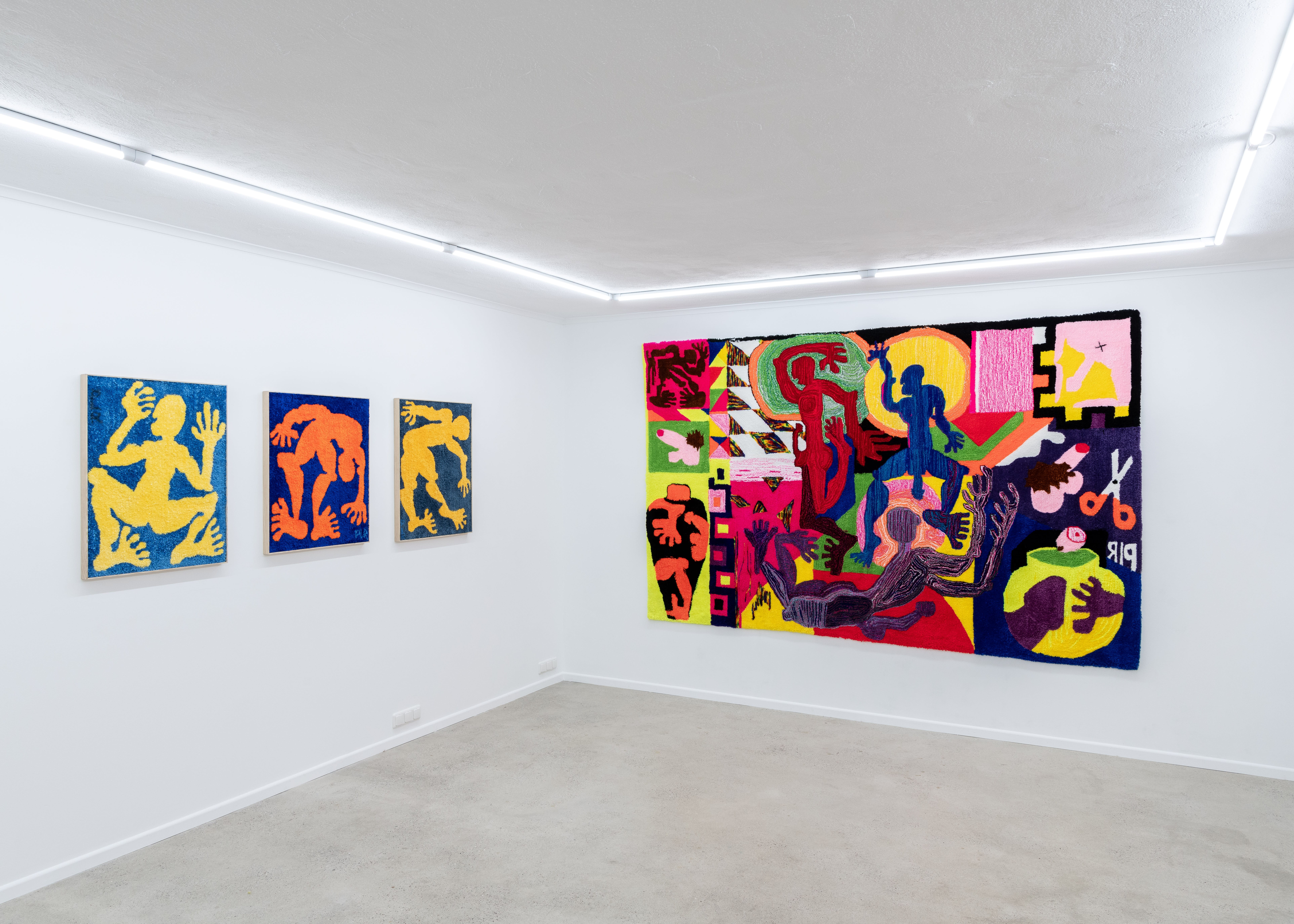
In Four Places at Once, exhibition view, 2024, Ronewa Art Projects, Berlin, Germany. Photography by Jeremy Knowles.
AD: Urns are a recurring motif in these works and in your ceramic practice. What does this shape mean to you?
PLR: Firstly, I adore the shape of an urn, specifically the funerary urn. It’s not merely an aesthetic fascination but also a technical one: achieving the exact curvatures and shape of an urn is difficult. The outcome can be the difference between ending up with an urn, a jar, or even a vase if it isn’t lidded.
We’re familiar with urns as containers for the ashes of deceased loved ones, to either personally keep or store in niches at religious buildings. For me, the idea of storing remains extends to memory as well. The urns I create are empty, but every single one is built and adorned with a particular memory involved, be it a of a person, alive or dead, or a significant moment in my life.
AD: Tell me about your use of handcrafts – knitting, tapestry, embroidery. Do they hold a personal significance for you?
PLR: Initially, my use of handcrafts was a decision based on practicality during my art school undergraduate years. I completed my bachelor’s degree through distance learning and was therefore deprived of an arts campus and all its equipment. I resorted to using self-taught handcrafts as an affordable and accessible medium I could work on remotely.
As a sculptor, I see handcrafts in the same light as sculpture. Although most of this work results in what can be considered a two-dimensional image, I think of them as three-dimensional objects, which involve three-dimensional thinking.
I’m also interested in how handcrafts, particularly textiles and fibers, can be seen as a form of women’s work. I enjoy reversing these gender roles, for example, juxtaposing them with imagery often associated with the masculine, like rugby, soft-core straight pornography, and enormous phalluses.

Tapestry in progress, Pierre le Riche's studio, Aachen, Germany. Photograph: Courtesy the artist.
AD: What do you enjoy about working with thread and yarn as art materials?
PLR: They are incredibly versatile in color, texture, size, and how they can be manipulated. I have used fibers in the ways one might expect, such as embroidery and tapestry, as well as creating drawings, sculptures, and even large-scale installations.
AD: Your tapestry designs are based on sketches. Tell me about your sketchbook. Is it a form of autobiography or diary?
PLR: My sketchbook is my portable studio. I am fortunate enough to have a studio at home, and when I am away from home, it is frustrating if I cannot immediately explore spontaneous ideas. I have ADHD, so I need to work on an idea as soon as it comes to life because I will be completely disinterested in it shortly.
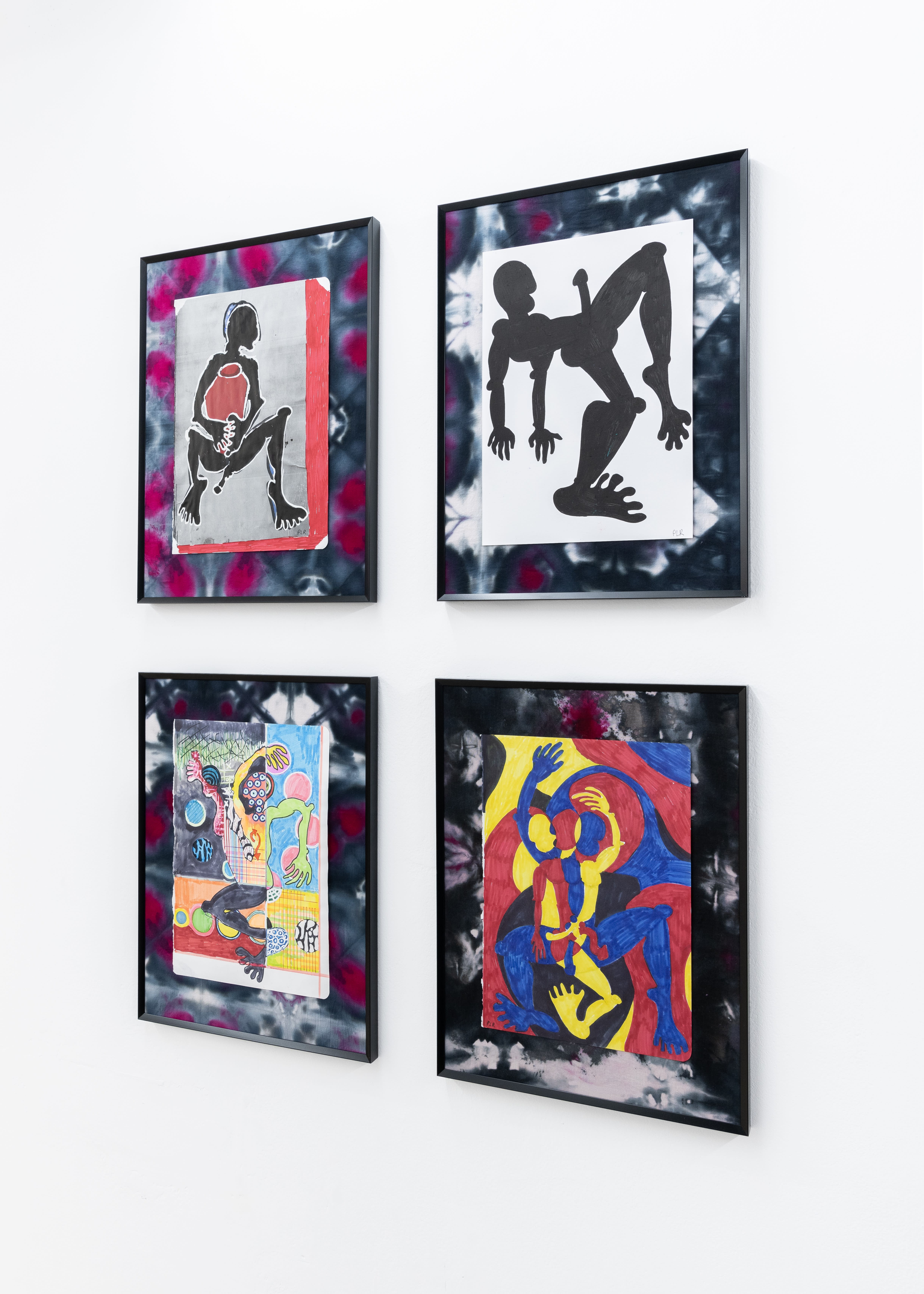
Four sketches on hand-dyed fabric, installation view, 2024, Ronewa Art Projects, Berlin, Germany. Photography by Jeremy Knowles.
AD: Your figures are cartoonish, primitive forms with bold colors and lines. How did you develop this style?
PLR: It is a peculiar story. In 2021, I had surgery and was given strong pain medicine as part of my aftercare. The medication gave me intense visions of prancing black-and-white figures. Interestingly, I always had nightmares in black and white as a child. I began drawing these figures when they visited me more often. As an artist who never enjoyed figurative work, I was stunned by how consistently I drew them. Yes, they are anatomically incorrect in every way, but they all conform to a distinctive style in line and form. I must have developed a muscle memory for them from drawing figure after figure.
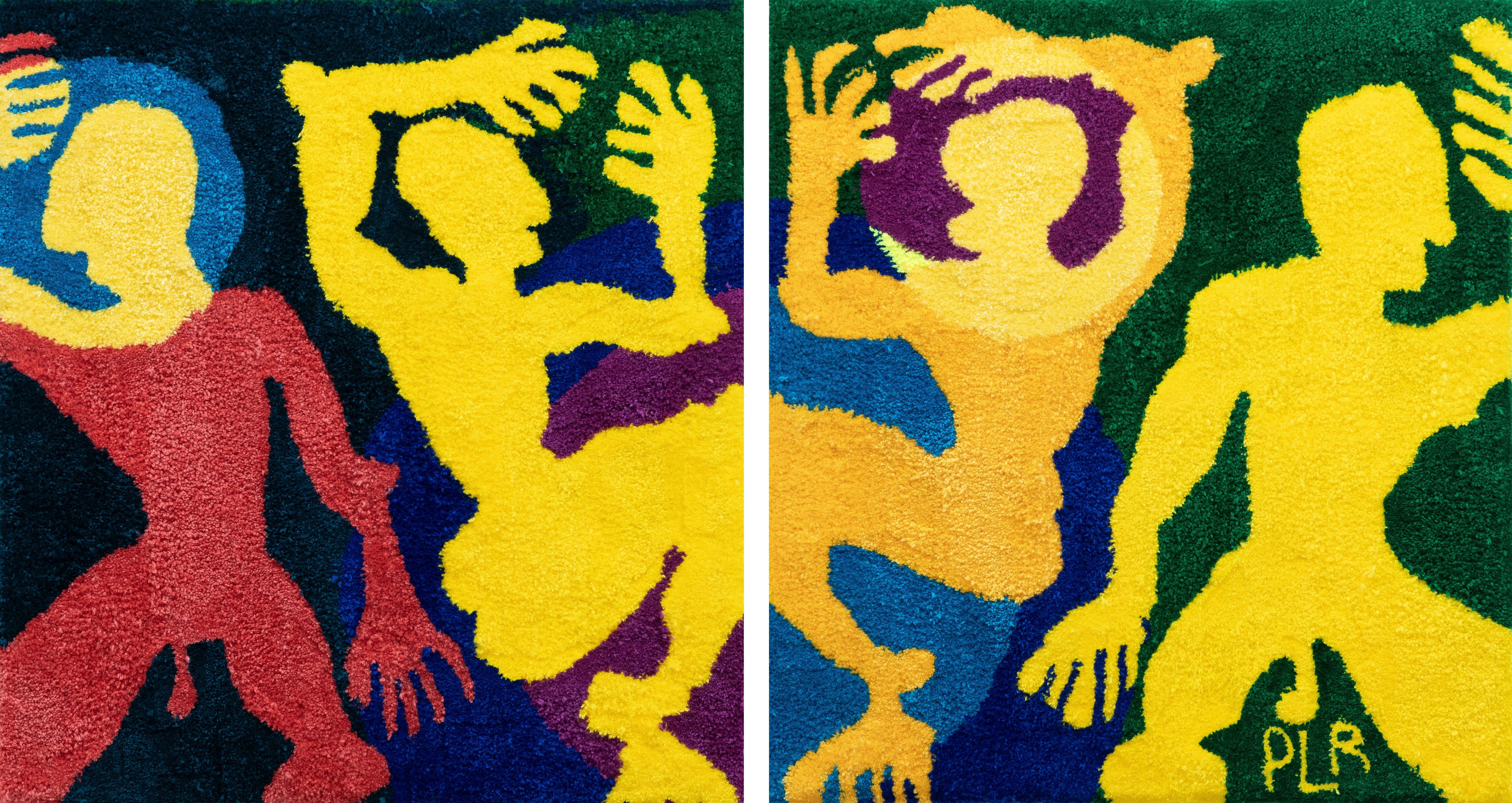
'Searching for Grenner Pastures', 2023, Acrylic yarn on polyester and paint, diptych, each panel 75 x 70 cm, 29 1/2 x 27 1/2 in. Photography by Jeremy Knowles.
AD: The tapestry piece 'Urns for the Ashes of My Lost Lovers' is enormous at nearly three meters wide. Working on such a scale must be physically demanding. I’m interested in the physical process of creating your large tapestries. For example, how long did it take to create this work? How much yarn is used?
PLR: 'Urns for the Ashes of My Lost Lovers' is the first tapestry I made. It was shortly after I started drawing these figures in my sketchbook, so I incorporated a lot of ideas and experiments into this gigantic piece. You’ll notice less refined shapes and more freely drawn lines and color work on this tapestry compared to later, more stylized ones. It is perhaps still my favorite work.
I make the tapestries using an electric tufting gun, which is a surprisingly quick process. But as I was still getting a feel for the tools and materials when creating this piece, I estimate about 150 hours went into it. As for the quantity of yarn, it contains approximately 5000 meters. It could be even more!


Add a comment